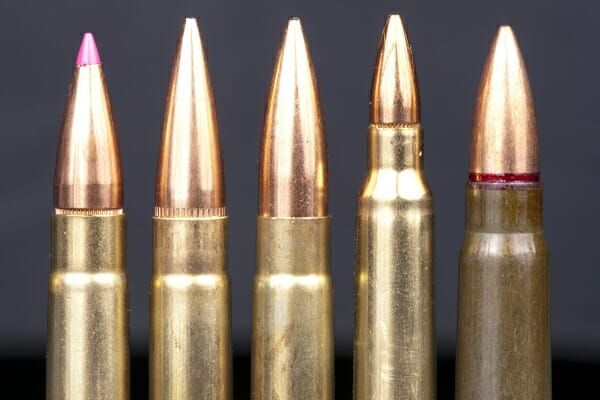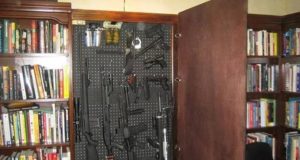Along with the rising popularity of gun mufflers, usually called suppressors or silencers, has come an increased interest in subsonic ammunition. Often, though, there are more questions than answers.
This article seeks to inform the reader with basic knowledge of subsonic ammo.
Subsonic ammunition is ammunition made primarily for use with a suppressor. It also can be used in a handgun or rifle all by itself, unsuppressed, though weapon performance may not be the same as with regular ammo.
When compared to other cartridges within the same caliber, subsonic loads have a smaller powder charge inside the case, and are generally a heavier bullet. In extraordinarily simple terms, we can think in terms of the formula mass times velocity equals force. When velocity is decreased by having less powder, and therefore less gas to drive the bullet down the barrel, through the air, and into its target, a bullet of more mass compensates to a degree. For example, Atomic Ammunition’s subsonic load in .223 has a 75-grain bullet — not an extraordinary weight, but one associated with match rounds. An average .223 target match bullet weighs 55 grains.
The Self-Defense And Hunting Weapon That Doesn’t Require A Firearms License!
It is the moment a bullet leaves the barrel, and the explosion of gas that’s behind it, that creates the “bang” of a firearm. Subsonic ammunition, traveling at lower-than-normal velocity relative to the caliber, is quieter. It still, though, makes enough noise to necessitate hearing protection when used sans suppressor.
Story continues below video
In tandem with a suppressor, subsonic ammunition makes a hearing-safe pop, the kind you hear in the movies when the bad guy fires a gun with a silencer. Funny, isn’t it, how it’s always a bad guy in the movies? On the street, most criminals aren’t interested in making the effort to conceal these bulky attachments.
Why Use Subsonic?
Subsonic can be used when less noise and/or less recoil are desired. It’s a great choice for indoor or urban ranges. With a suppressor, it’s beneficial for hunting, especially when a landowner may want to eliminate more than a single varmint or pest animal. The minimal report is less scary to the rest of the herd. Some hunters claim the remaining animals may still spook, but since subsonic offers no muzzle flash and no directional bearing on sound, they actually may run in the hunter’s direction.
It’s also a good choice for teaching gun handling and marksmanship fundamentals to a new or very young shooter without the complication of recoil.
Be Prepared. Learn The Best Ways To Hide Your Guns.
Subsonic protects the irreplaceable asset of hearing. Quieter shooting is an asset not just for gun users, but also for non-shooting neighbors who are less likely to object to our hobby — at home as well as in the voting booth.
What Are the Downsides?
Some subsonic loads will, consistently or occasionally depending on the semi-auto firearm, fail to automatically cycle the action. This challenge is gradually being overcome as manufacturers fine-tune components. I found it to be quaintly enjoyable to hand-cycle my AR-15 while using subsonic.
A notable exception is the popular .300 AAC Blackout caliber, purpose-made for suppressed shooting. With a bolt carrier group and barrel change, it can be fired through the AR-15 platform. This widely available load offers the AR owner great versatility from one firearm, although many feel it’s unnecessary unless it’s used with a suppressor.
Subsonic ammunition is a bit less accurate at longer distances. The smaller doses of powder in subsonic loads can shift around within the case, producing less reliable flight. I experienced this in a 100-yard field trial of .308 caliber subsonic. In several three-shot groups, two rounds would be remarkably accurate; their impact holes touching. A third would be a modest flyer, three to five inches away from the others. It’s not a huge difference for most applications except where absolute precision is required.
According to Jerod Johnson, a company rep for Atomic Ammunition, subsonic rifle loads such as the .308 are rather ineffective beyond 300 yards, where velocity loss is rapid.
The price of subsonic is, like match ammunition, reflective of the specialized manufacturing process. Expect to spend double or more the price of FMJ.
If there’s no admonishment against subsonic ammunition in your firearm’s user manual, trying out a box of subsonic is an interesting experience, whether accompanied by a suppressor or not. Especially with centerfire calibers, there’s a surprising ease to firing powerful rounds, while getting sound and recoil that are closer to the rimfire range. Try some!
Have you ever used subsonic ammo? Share your thoughts on it in the section below:
 Off The Grid News Better Ideas For Off The Grid Living
Off The Grid News Better Ideas For Off The Grid Living




